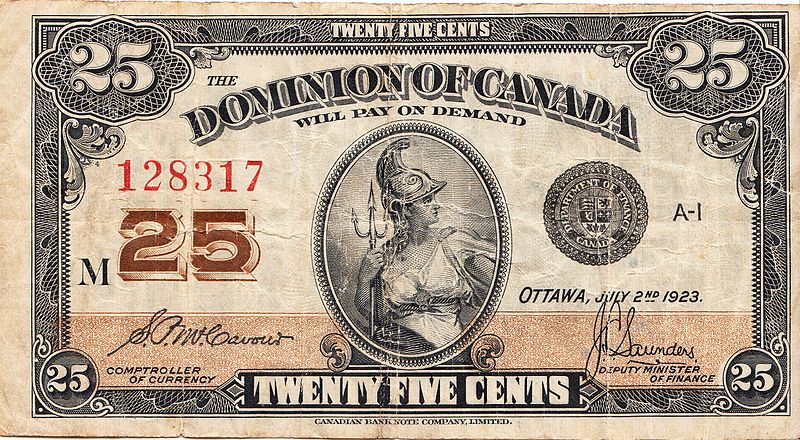As it stands today, Canada only has 5 bills being issued: $5, $10, $20, $50, and $100. In the past though there were a lot more, not only because the $1 and $2 bills were replaced with coins. But to tell this story, we have to start before Canada was even a country, back at the War of 1812.
The first money printed in Canada that were denominated in dollars were Army Bills, made to help finance the war effort during the War of 1812. The public was distrustful of paper money at the time, but when the British Government redeemed the money at its face value, the public began to trust the currency and not just precious metals. This lead to more paper money being produced by banks throughout the 1821 to confederation in 1867. Due to each bank being able to produce money, a wide variety of bills were created including $1, $2, $3, $4, $5, $10, $20, $25, $40, $50, $100, $500, and $1000.
In 1867, confederation occurred and the Dominion of Canada was created, spurring the design for one currency across the nation. The Province of Canada was the most prolific issuer of paper money before confederation, so its currency became the national currency. In 1870, the first Dominion of Canada bills were issued in 25¢ (nicknamed the shinplaster and seen above), $1, $2, $500, and $1000 denominations, with $50 and $100 notes being added in 1872. With the bulk of the currency in $1 and $2 bills, a $4 denomination was added in 1882 followed by the $5 bill in 1912. The 25¢ bill was last issued in 1923.
During this time period, individual banks still issued their own currency. The Bank Act of 1871 prohibited the issuing of anything less than $4 from these banks and raised this to $5 in 1880. This left all the lower denominations to the Dominion of Canada to print, which is why there was such demand for their $1 and $2 bills. To not be completely removed from this market, other banks started printing unusual denominations such as the $6 and $7 bills from Molsons Bank in 1871. These bills, when combined with the $5 they were already printing, would allow people to pay $2 by giving $7 and receiving $5 change (and similarly $1 with the $6 bill).
In 1934, the Bank of Canada was founded and began issuing $1, $2, $5, $10, $20, $25, $50, $100, $500, and $1000 bills in 1935. After ten years, the Bank of Canada became the only bank that could issue money, which is unchanged to this day. Unique to this first run of bills was the purple $25 in honour of King George V’s Silver Jubilee and the $500 bill (only 46 of which are still unaccounted for). Unfortunately, all of these bank notes were printed separately in both English and French and changes in legislation in 1937 required that the bills be bilingual, prompting a new series of bank notes to be printed.
From 1938 to 1979 there were two more series of notes issued, one in 1954 and the other from 1969 to 1979. These bills had the same denominations as the 1937 series but the artwork changed and old bills were taken out of circulation as they started to wear out. It wasn’t until the Birds of Canada series was issued in 1986 that the $1 bill was not updated to the new look, followed by the $1 coin being minted on June 30, 1987 and then $1 bill being withdrawn from circulation exactly two years later.
In 1996, the $2 bill was removed from circulation and replaced with the toonie, a $2 coin. It wasn’t until 2000 that the $1000 bill was retired, mainly due its use in money laundering and organized crime. This meant that when the Canadian Journey series was issued from 2001-2006 it only contained five notes: $5, $10, $20, $50, and $100. As of 2011, the Frontier Series began being issued which involved Canada’s transition from paper bills to polymer. The series is planned to finish by the end of 2013.
Today’s Tangent: Think the largest denomination in Canada is only $1000? Think again. In 2007, the Canadian Mint issued a 100 kg gold coin with a face value of $1,000,000; the world’s first million dollar coin. At 99999 pure gold, it’s worth more than five million dollars and so far five investors have bought one.
